Things to Do in Lin, Albania: Lake Ohrid & More
11 min readLocated on the Albanian side of Lake Ohrid, around 2 hours by car from Tirana, Lin is a pretty fishing...
Located on the Albanian side of Lake Ohrid, around 2 hours by car from Tirana, Lin is a pretty fishing village with sights that range from ancient Roman mosaics to what is arguably Albania’s most photogenic bunker.
Lin also happens to be the oldest known inhabited settlement in Europe. In summer 2023, archaeologists discovered evidence of an 8,500-year-old stilt village submerged nearby in the lake.
We stayed in Lin on the final night of our Albanian road trip. Scenic, laidback and quaint, it was the perfect conclusion to our 2-week itinerary.
In this guide, I will show you all the best things to do in Lin, what is worth seeing nearby, plus where to sleep and eat.
Please note: This post contains affiliate links, meaning I may earn a commission if you make a purchase by clicking a link (at no extra cost to you). Learn more.
Why visit Lin?
Lin made headlines in 2023 when a team of researchers discovered the submerged remains of a stilt village dated to 6,000 BC. This makes Lin the oldest continuously inhabited village in Europe.
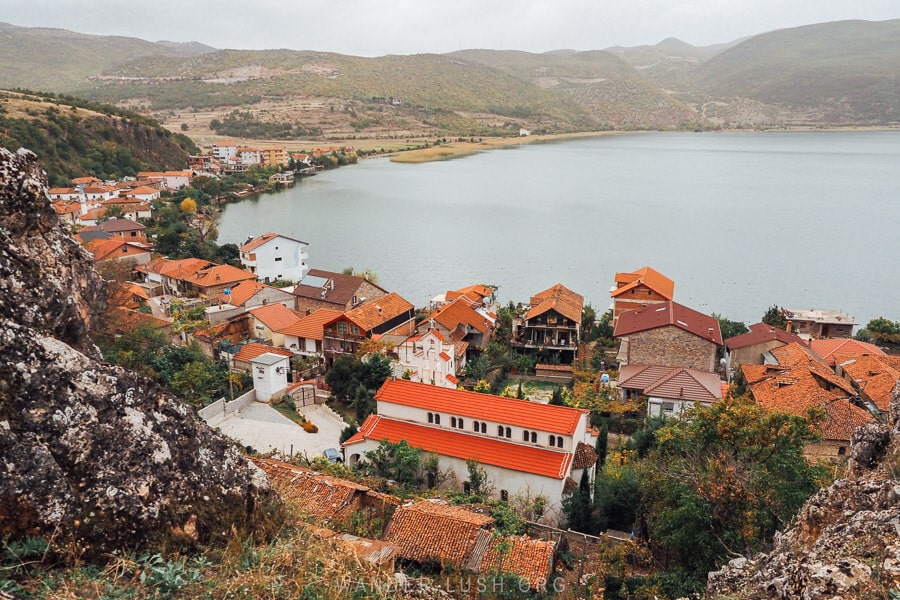
But even before these latest findings, Lin was famed for its prehistoric sites. The Mosaic of Lin – an incredible full-floor mosaic that once graced the floor of a 6th-century Byzantine church – is one of Albania’s most important cultural monuments. Near to Lin, the Illyrian Royal Tombs of Selca is a tentative UNESCO World Heritage Site.
Having visited Ohrid back in 2019, I was intrigued to see how the ‘other side’ of the lake compared. My impression is that the Albanian side is more sparse and less developed compared with North Macedonia.
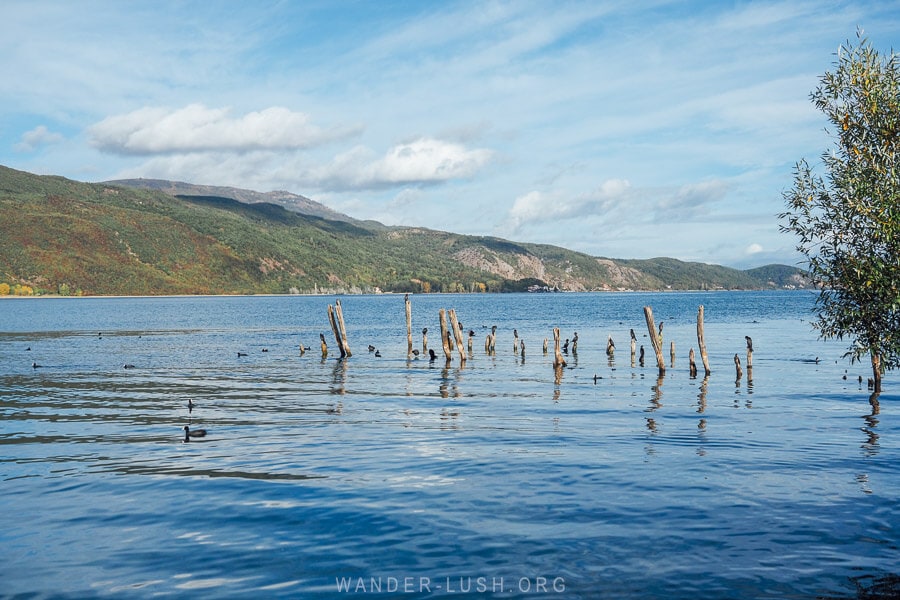
Pogradec, the biggest Albanian city on the lake, is 22 kilometres south of Lin. We also had a night here on our way in from Korca. Lin is much smaller, but more atmospheric than Pogradec – so if you only have time for one night on Ohrid, I would definitely stay in Lin.
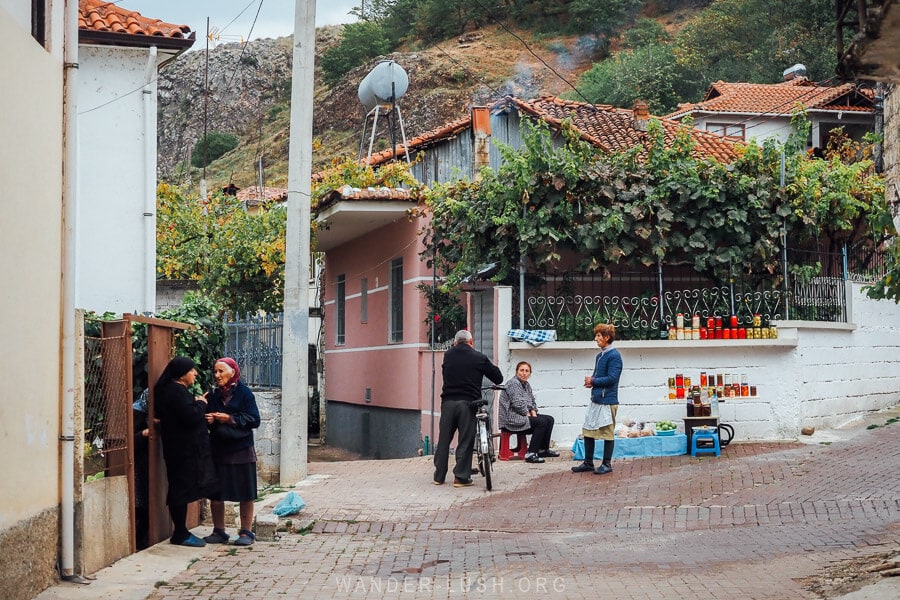
Aside from the history, Lin’s tiny size and the slower pace of tourism development makes it a nice place to experience village life. This is especially true if you stay at a family guesthouse – my recommendations are below.
Another reason to visit Lin is the bunker. Perched on the tip of the peninsula overlooking Lake Ohrid, it is both the most photogenic bunker in Albania (in my humble opinion), and one of the most unique, having been transformed into a tiny chapel.
How to get to Lin
Lin sits on a peninsula on the north-eastern side of Lake Ohrid, a short detour from the main highway between Korca and Elbasan/Tirana. If you are using public transport to move around Albania, any bus that connects these cities will be able to drop you at the turnoff for Lin. From the highway, it is a 1.5-kilometre walk into town.
Having your own car in Lin is a big advantage as you can drive all the way into the village and explore the surrounding area with greater freedom.
If you are staying overnight, parking is available in the village – my recommended guesthouse has a designated spot. If you are stopping in Lin for a short visit, consider leaving your car at this parking lot and walking the rest of the way (around 30 minutes by foot to the centre of the village).
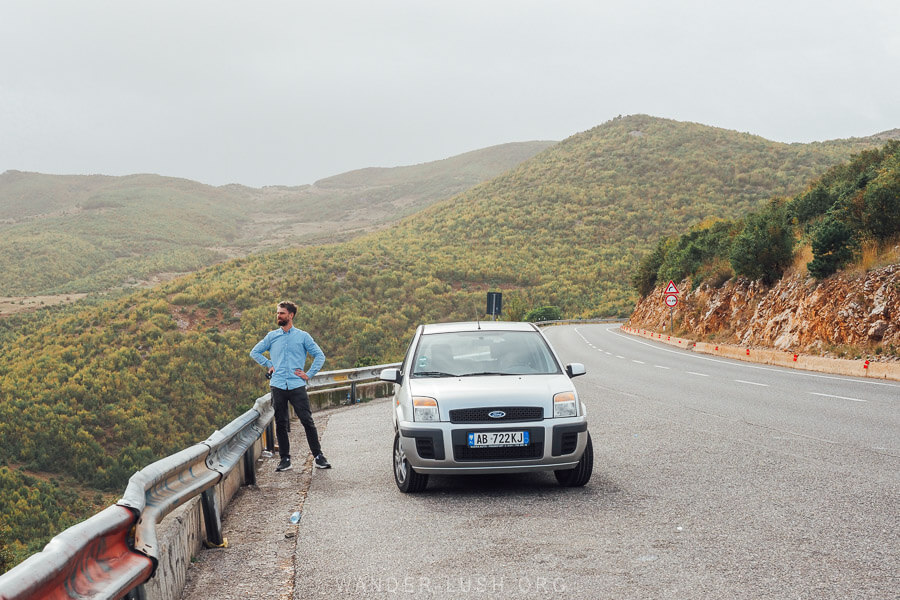
Thinking of self-driving in Albania? I recommend hiring a car from a local agent via Local Rent. Prices are competitive, and most vehicles do not require a cash deposit or a credit card. I used Local Rent on my recent trip to Albania and couldn’t have been happier with the service.
To reach Lin from Tirana, follow state highway 3 via Elbasan (2 hours travel time). From Korca, we used the E86 highway via Pogradec (75 minutes travel time).
Lin sits at the bottom of the Qafe Thane mountain pass. Be sure to stop at this marked viewpoint (on the left-hand side of the highway) on your way in or out of town for a panoramic view of the village and lake.
Where to stay in Lin
House 1960 in Lin is one of my favourite accommodations in Albania. Rooms mix heritage stone and timber details with boho-esque furnishings, plants and macrame. The design is just lovely.
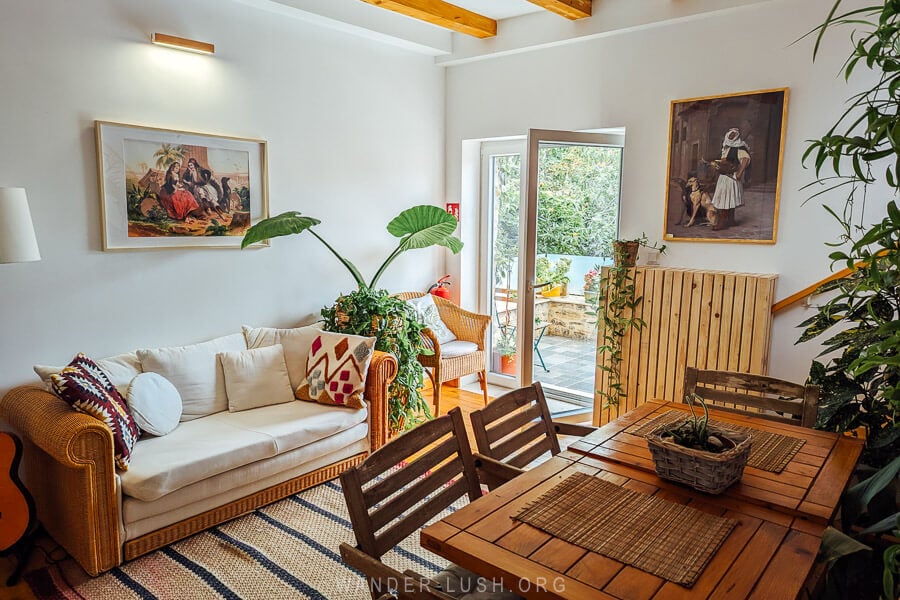
The house has a rooftop terrace with views of Ohrid Lake and the mosque. If the weather is fine, breakfast and dinner are served up here.
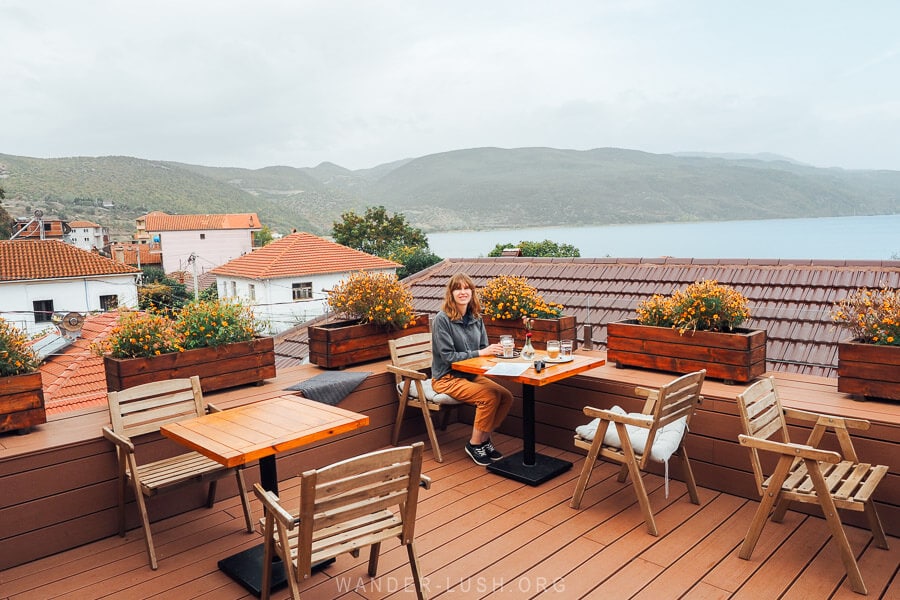
It’s the hosts, Merita and Emri, who really make this place special. Merita’s home cooking is excellent, so I do recommend eating a meal here. Guests are kindly asked to put in their lunch/dinner orders from the menu supplied in every room with at least 3 hours’ notice.
We had a very tasty fish dinner at House 1960 (see below) and two big slices of homemade baklava for dessert. The complimentary breakfast is also very good.
Check prices and availability for House 1960 here on Booking.com.
Things to do in Lin & nearby
See the Mosaic of Lin
Lin’s Byzantine mosaic is by far the village’s most popular attraction. It is located at the highest point of the peninsula, atop a rise that can only be accessed from one side by climbing the steep laneways and stairs through the village. Look for the signs pointing to the basilica – and if in doubt, ask one of the locals.
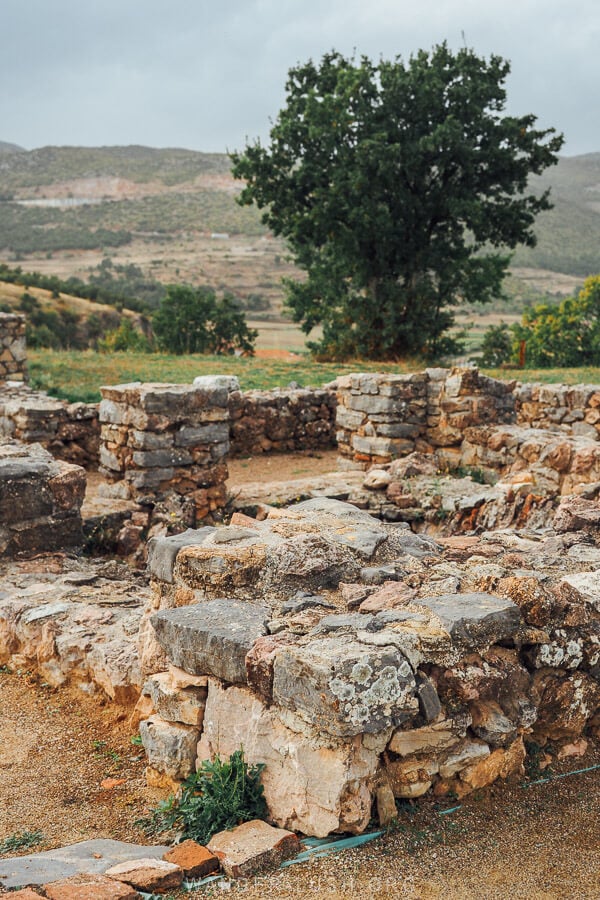
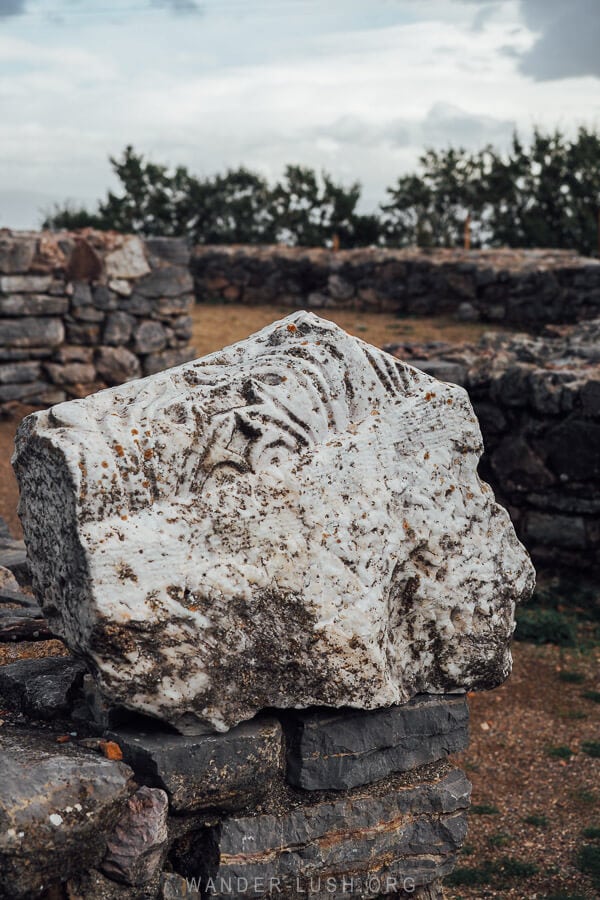
The Lin mosaic is spread like a rich carpet across the floor of a Paleo Christian church. The walls of the original basilica (and a younger temple that was erected on top of it) have been reduced to their stone foundations. But large swathes of mosaic remain in remarkably good condition.
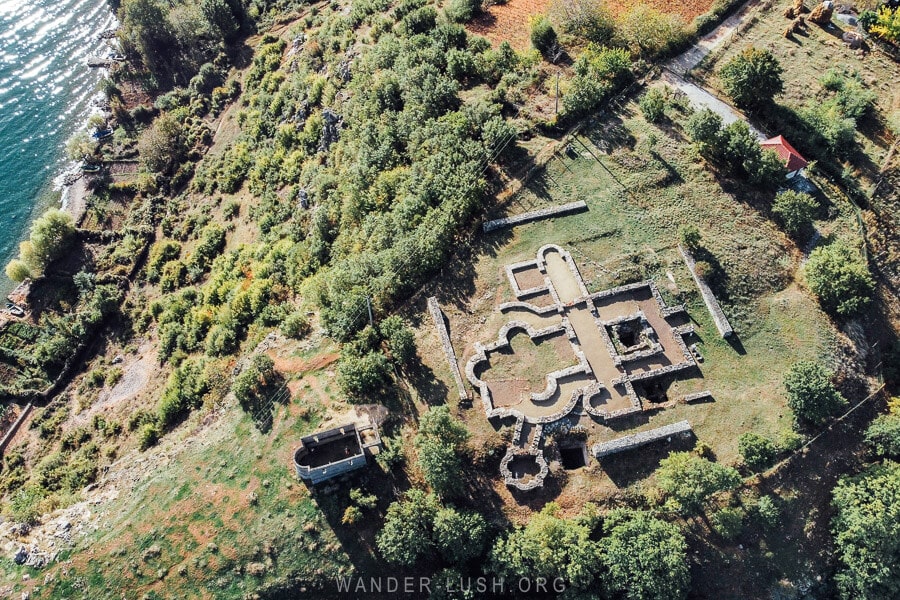
The mosaics, first discovered in 1967, combine both geometric and figurative designs that depict flora and fauna from the lake ecosystem mixed with ecclesiastical imagery, including an epitaph from the Psalm of David.
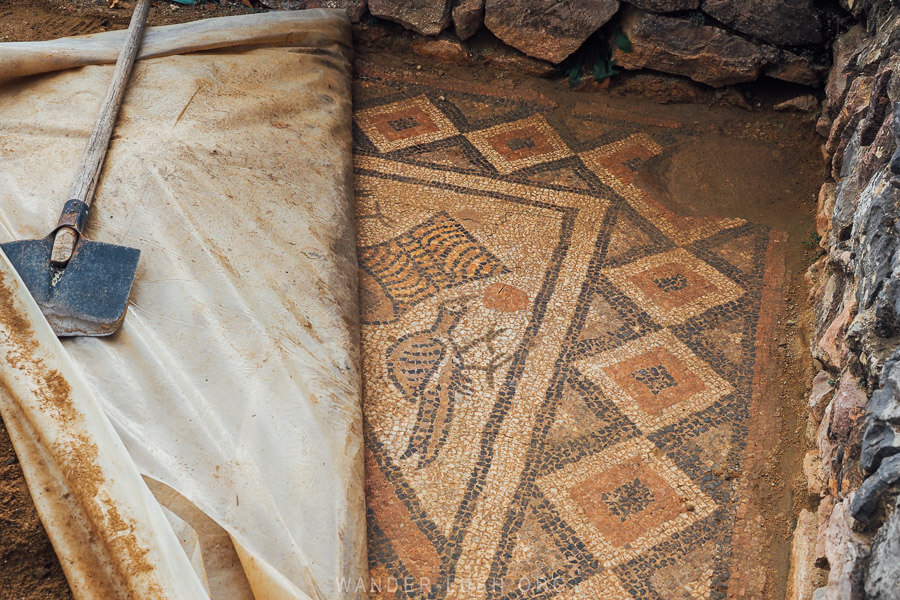
Efforts have been made over the years to protect and showcase the mosaic – in the early 2000s, a roof was partially constructed over the basilica, but on the recommendation of UNESCO it was later removed. (The mosaic falls under the 1979-inscribed UNESCO Site, the Natural and Cultural Heritage of the Ohrid Region.)
To save the mosaics from the elements, they are now completely covered in plastic, heaped with a layer of dirt. This makes it impossible to view the mosaics – apart from during a short window every autumn when they are temporarily uncovered. It is the same story in Butrint Archaeological Park, where the Baptistry mosaics are covered in sand.
The basilica is encircled by a fence, which is kept locked at all times. When you arrive, call the number on the sign and a caretaker will come up to let you in. He will also use a shovel to carefully uncover a small corner of the mosaic for you.
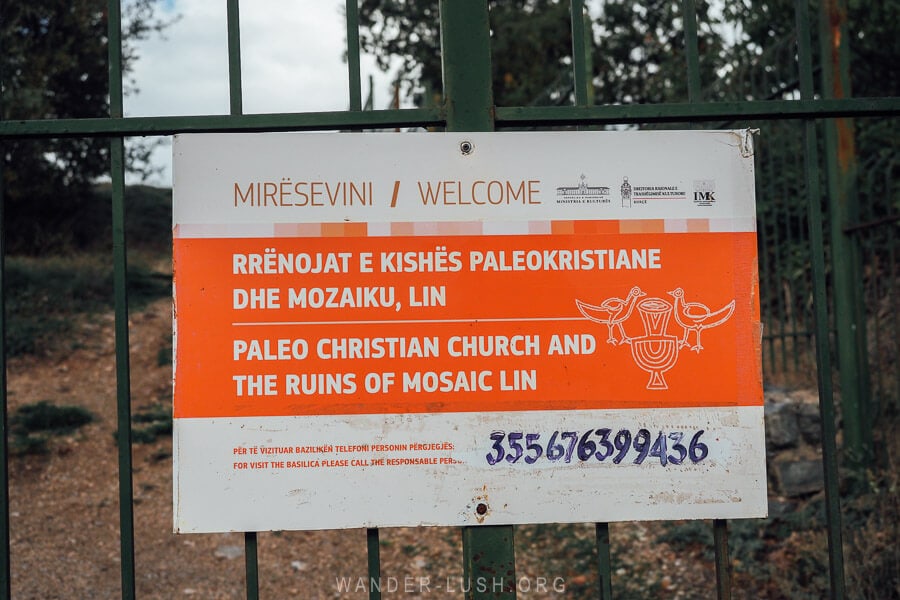
The caretaker we met took around 15 minutes to arrive when we called him on a weekday afternoon. He was very kind and gave us a nice explanation of the site.
Walk out onto the peninsula for a view
The peninsula that the basilica sits on steeply falls away into the lake on both sides. It’s possible to walk all the way out to the tip of the promontory and feel like you’re floating over Ohrid.
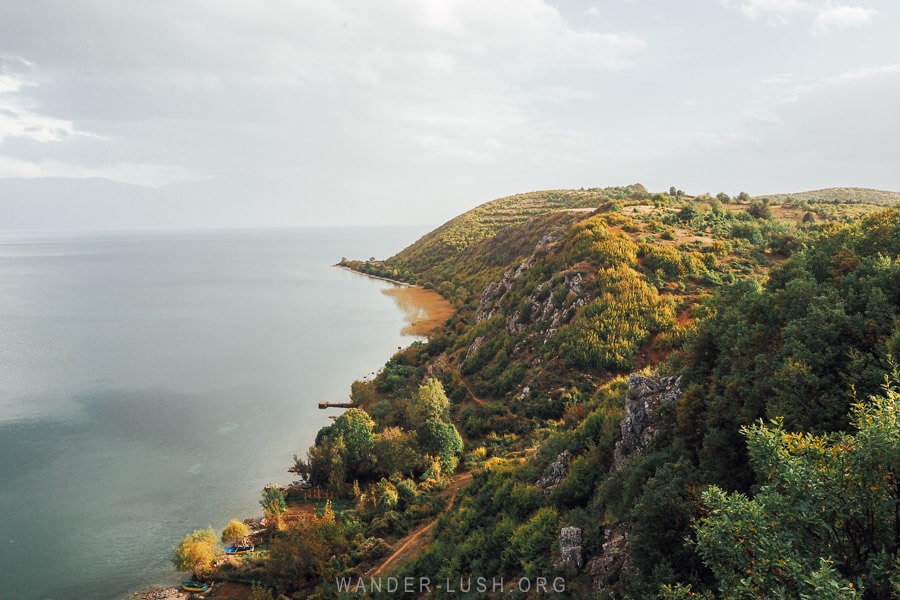
The short hiking path starts along the right-hand side of the fence that encircles the mosaic. Follow it all the way out, carefully climbing over the rocks and stones towards the end to reach the apex.
The views back down over the village from the headland are very beautiful. The best bit doesn’t reveal itself until the very end.
Photograph the Lin Bunker
Sitting at the far tip of the peninsula, the Bunker of Lin is sunken down far enough that you can’t see it from the path until the very final approach. The concrete dome suddenly comes into view, backed entirely by the glassy blue waters of Lake Ohrid.
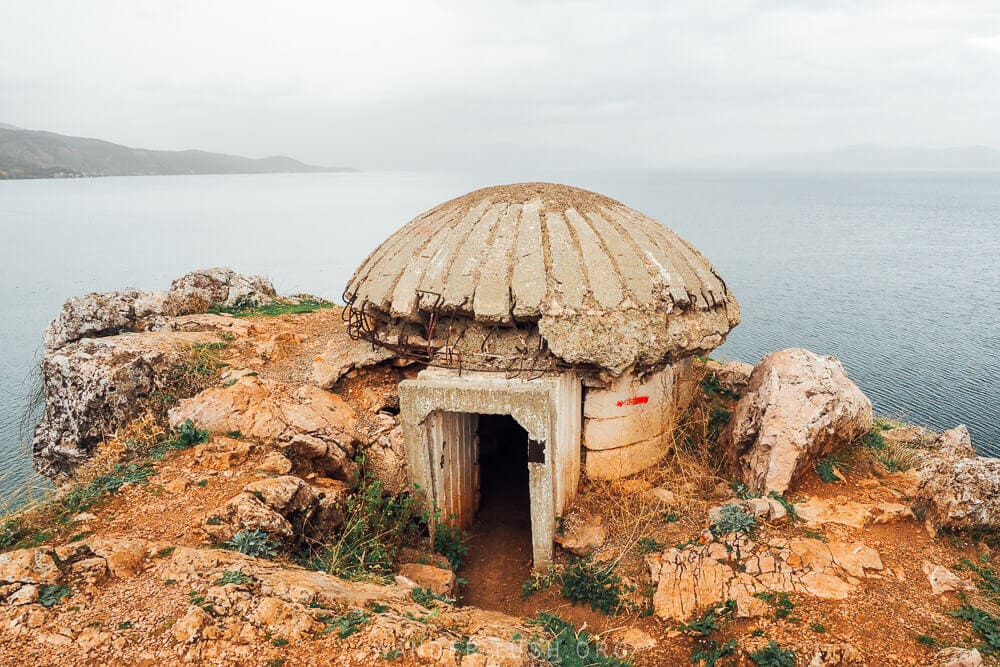
Sure, the famous Saint John the Theologian Church on Lake Ohrid is pretty – but the Lin Bunker is beautiful in its own way. Most bunkers in Albania (there are well over 150,000 of them) are not exactly photogenic. This one has the best location by far.
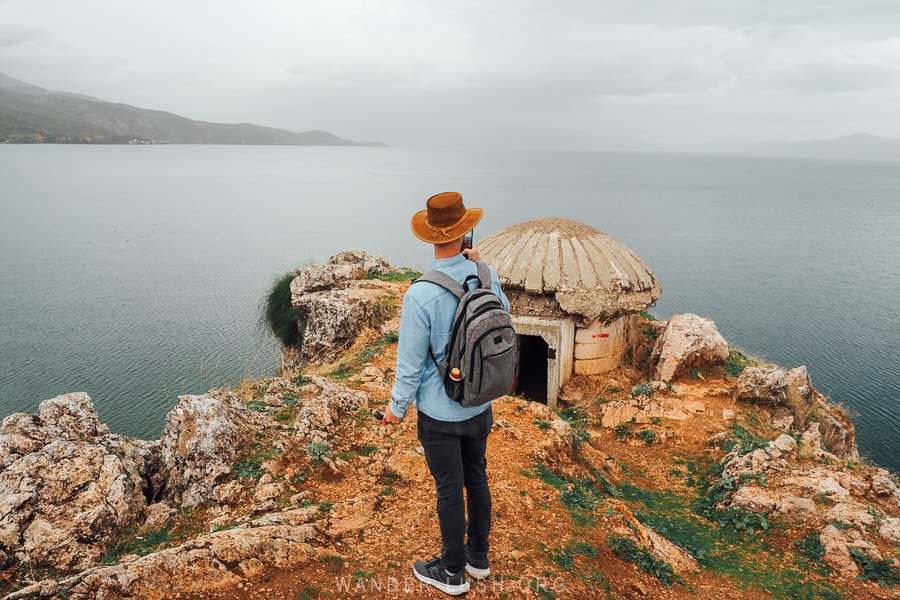
It’s possible to crouch down and walk inside the bunker. The interior has been converted into a small Orthodox chapel, with framed icons tacked to the concrete walls and votive candles suspended on the earth floor.
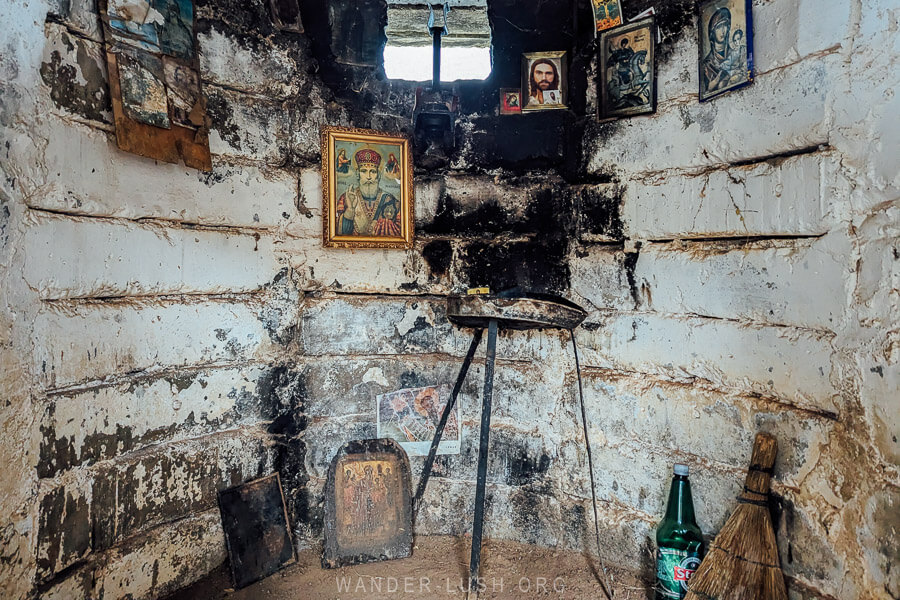
It reminded me a lot of the tiny ‘chapel in a tree trunk’ in Kutaisi, Georgia.
Explore the old streets
Lin is a compact town with one main street. The steep lanes that lead up to the mosaic and bunker are particularly pretty. I also recommend walking the length of town, out to the water. It takes less than 15 minutes.
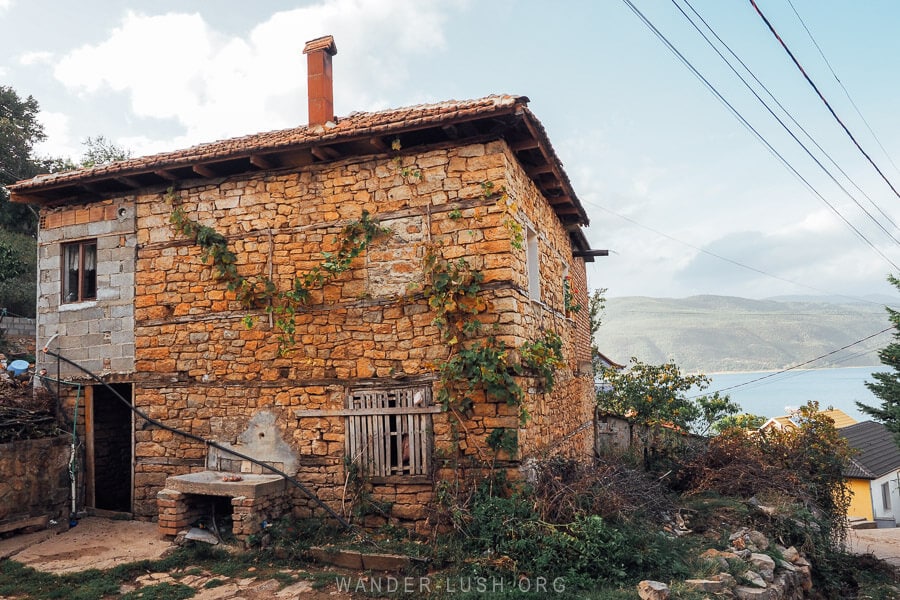
Between Lin’s tightly packed houses you will see the Church of Saint Varvara, a grand building with a Greek-style belltower, and right on the water’s edge with boats parked out the front, the beautiful Lin Mosque.
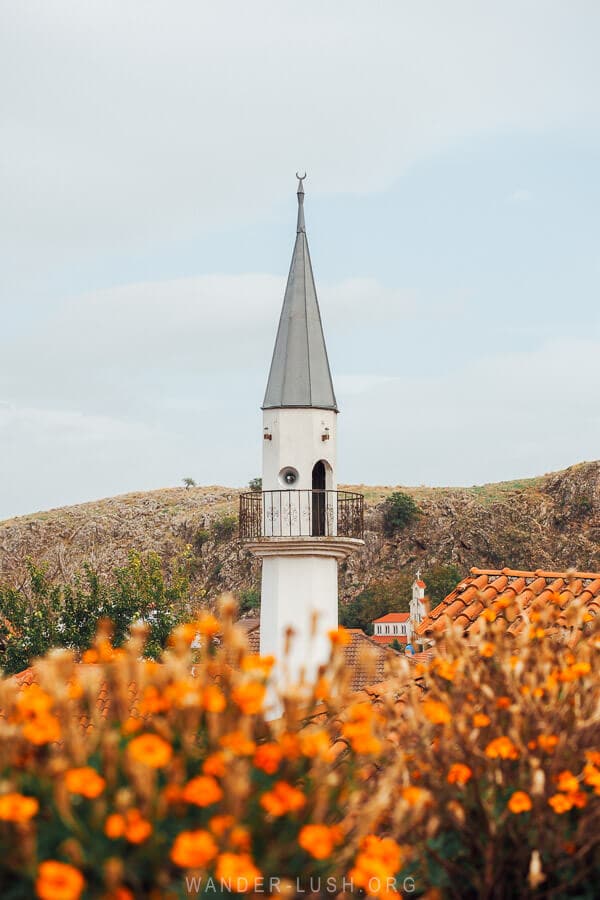
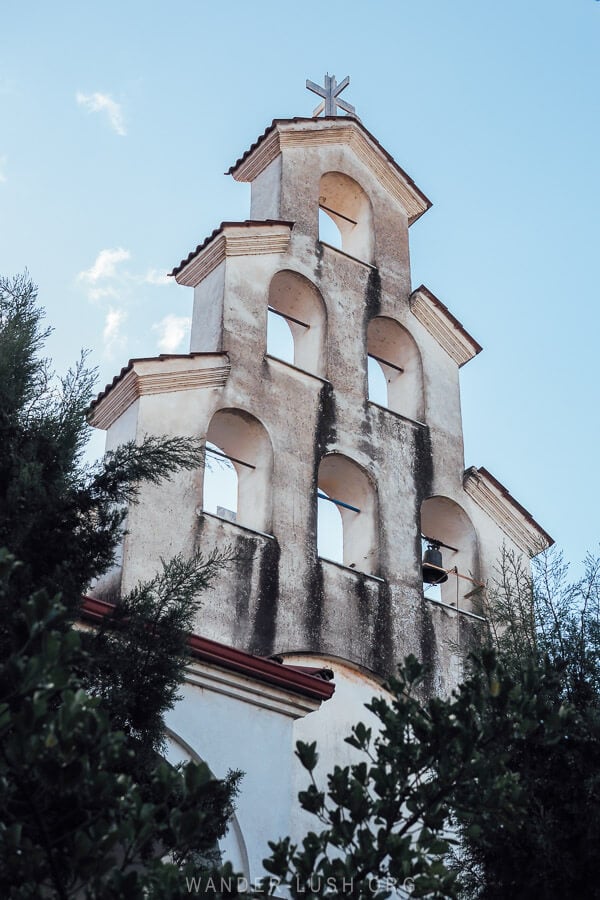
Every narrow laneway that leads off the main street will take you down to the water’s edge. Go for a stroll in the early morning and you might meet fishermen bringing in their catch of the day on sweet wooden boats branded with ‘Lin’ on the side.
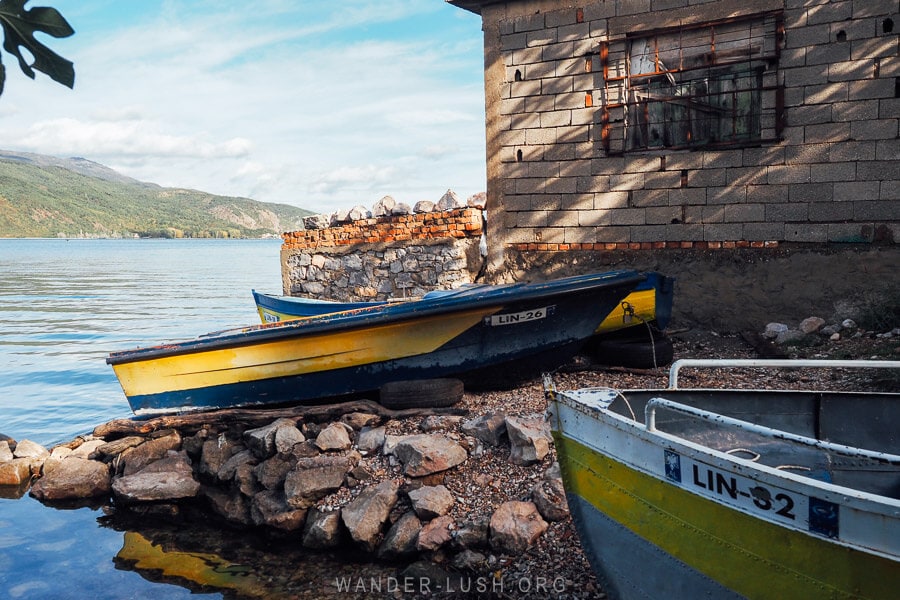
Buy local gliko or olive oil
There are little shops set up in the centre of Lin. The streets are so narrow, the ladies have to disassemble and rebuild their stalls whenever two cars need to pass each other!
Unlike in Berat where women sell textiles and lace, the Lin ladies trade in edible souvenirs – jars of pickles, gliko jams made from a colourful array of local fruits, olive oil, fresh produce, dried herbs and mountain tea, raki, and other treats.
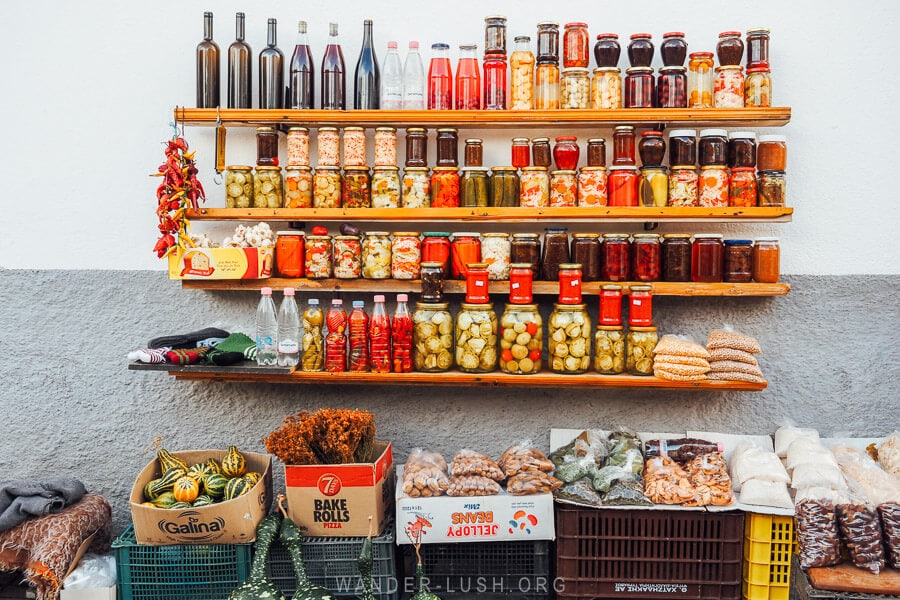
We bought a big jar of fig gliko that was so delicious, we polished the whole thing off in one sitting.
Eat fresh lake fish
Fish is quite naturally a favourite food in Albania’s lake region, as it is over the border. The lower-priced restaurants around Lin lure people across from North Macedonia for lunch – hence why you’ll see so many restaurants set up along the highway.
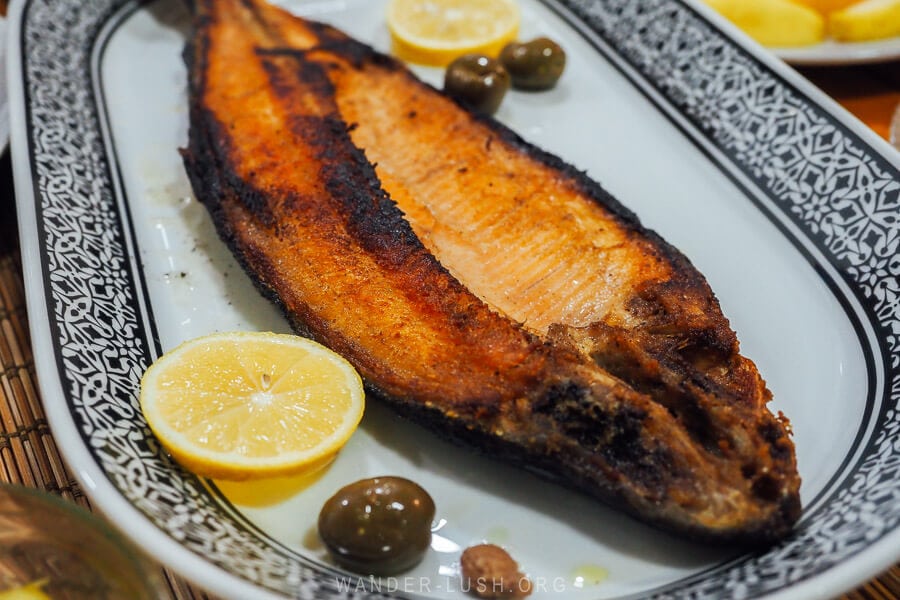
We opted to eat at our guesthouse and were treated to a delicious plate of chargrilled fish with all the fixings.
Visit the Royal Tombs of Selca near Lin
Once a stop on the Roman Via Egnatia that continued down to Thessaloniki, the ancient city of Pelion sits 1040 metres above sea level. Today this part of Albania is a sparsely populated pastoral landscape of rolling hills, patchwork fields and small villages.
The Illyrian kings used this territory as their residence between the 4th-1st centuries BC. The Royal Tombs of Selca is one relic from this period – it is an ancient acropolis containing five tombs carved from rock, each one decorated with a different assemblage of Ionic columns, antechambers and false doors.
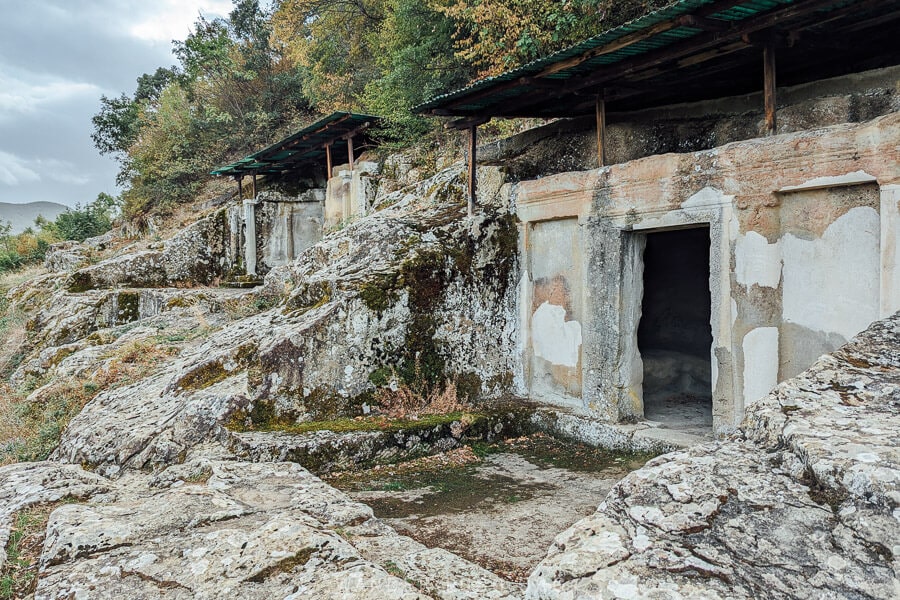
Getting to the tombs is a real adventure. From Lin, follow the highway towards Tirana then turn off in the direction of Fanjë, stopping to see the lovely three-arched Ottoman-era Golikut Bridge.
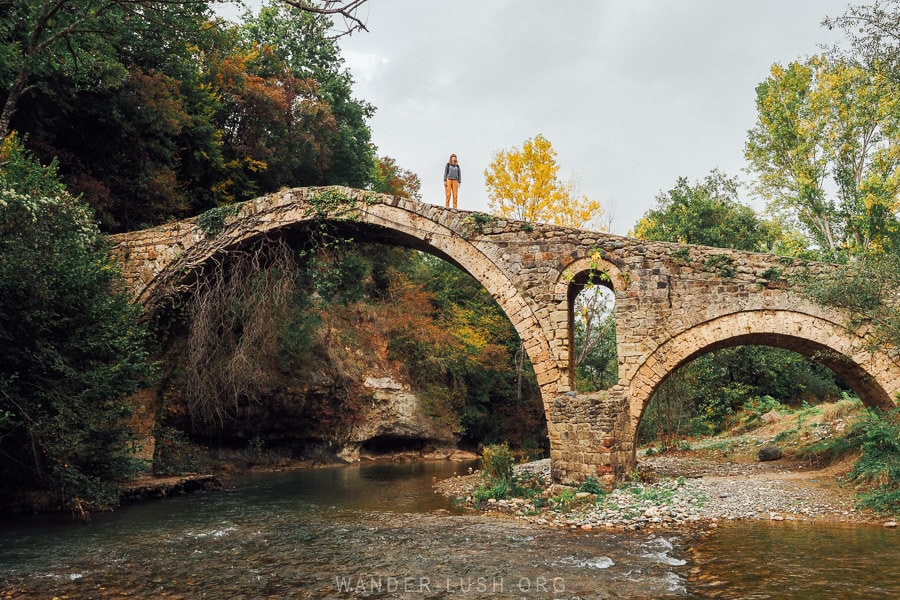
At the time of our visit there were roadworks going on in this area, and finding the correct road was a bit confusing. Follow the sealed bitumen road as far as you can, past the bridge, turn left onto the new bitumen, then continue along the concrete ‘road’.
The last part of the drive is quite hairy as the terrain turns to dirt (or mud). It is pretty neat driving directly through the small villages, all wood smoke and hay stacks.
Astonishingly there is virtually no signage. We parked our car near the one sign board then took a guess that the tombs would be located on top of the hill – we were right, thankfully. To find them, follow the concrete stairs all the way to the top. The first few tombs are nice, but the most impressive ones are around the corner.
Take a side trip to Pogradec
The city of Pogradec is the largest settlement on the Albanian side of Lake Ohrid. It doesn’t have the charm of Lin, but it is interesting in a different way (dystopian beach vibes, anyone?) and still worth a quick look in.
In fact, some of my favourite photos of Albania were taken during an evening stroll around Pogradec.
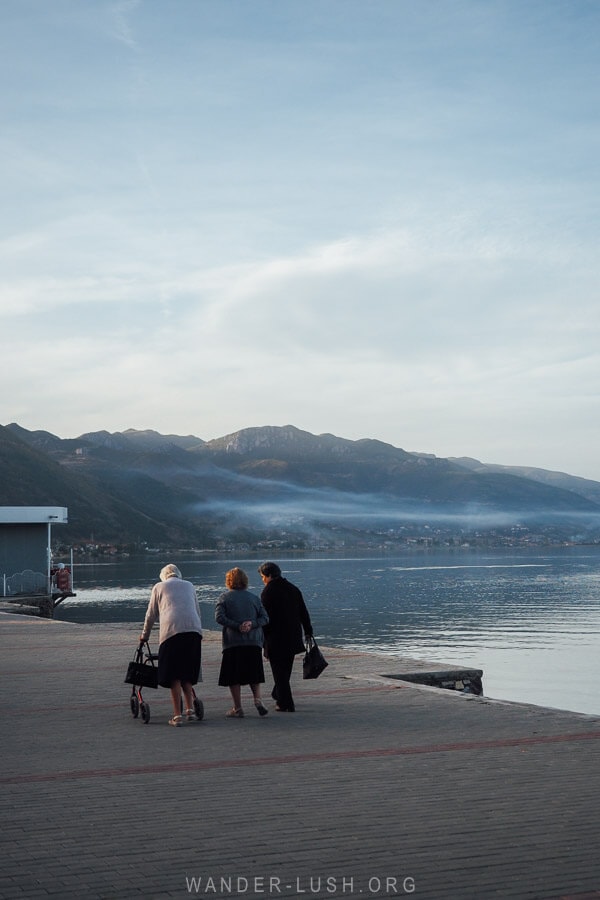
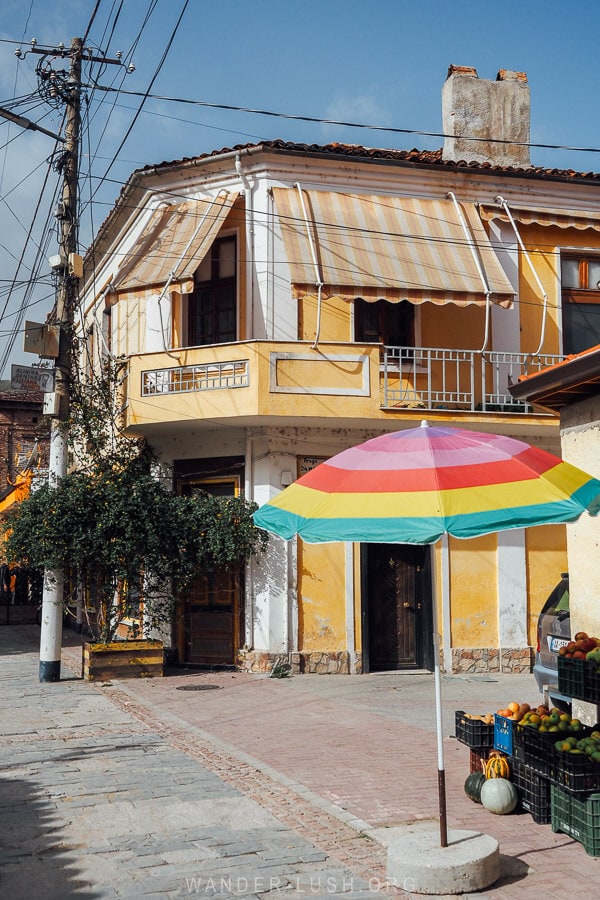
The wide boulevard that lines Pogradec’s lakefront is one of the best spots in the country for an evening xhiro stroll with the locals. It leads pedestrians past several landmarks, including an open-air amphitheatre (note that the capital columns mirror designs found at the Selca Tombs), various statues, and a small jetty.
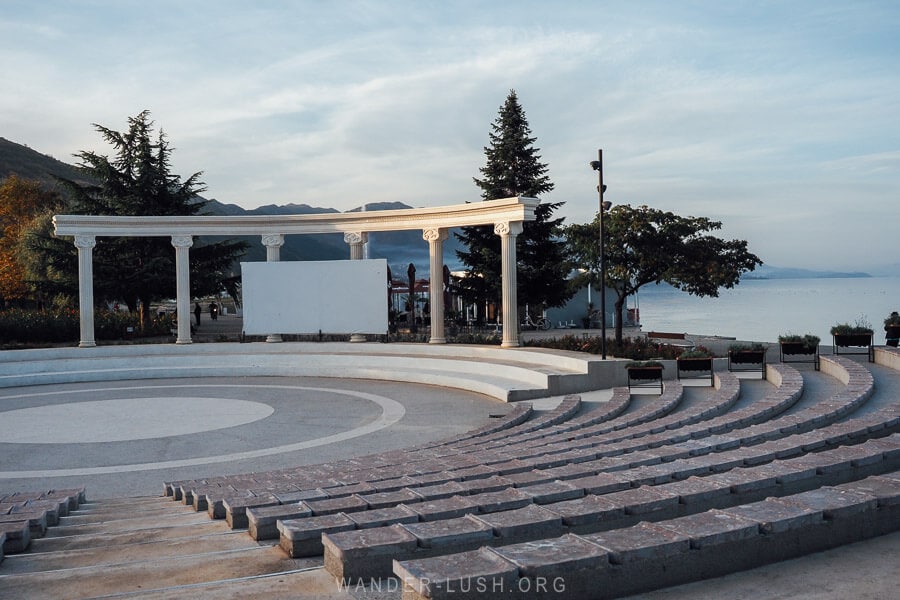
I also recommend walking through the old part of Pogradec on the north-western side of town. Known as Toplec, one blog I read said the neighbourhood is ‘often compared to Tuscany’ – I’m not sure about that! The streets are cobbled, and there are several nice old houses that have been preserved.
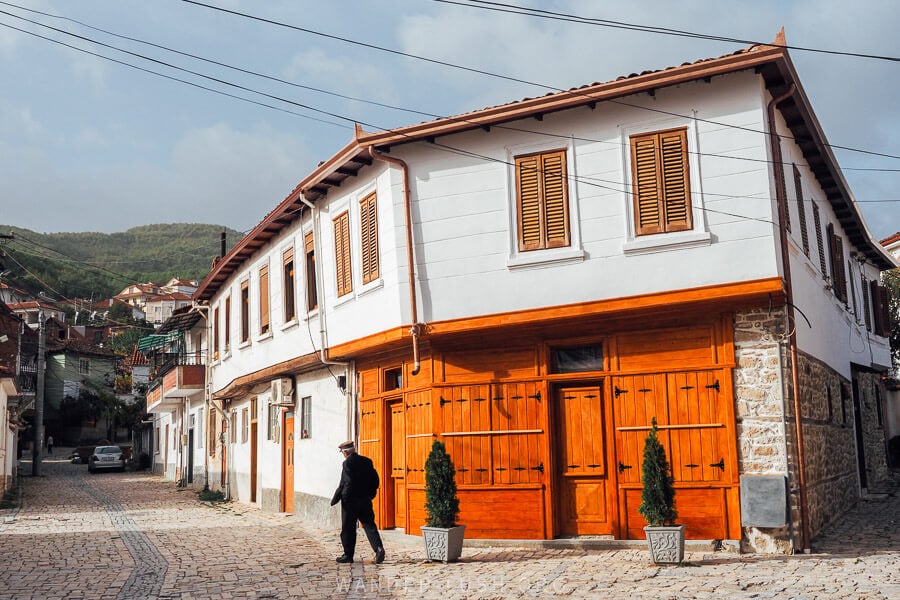
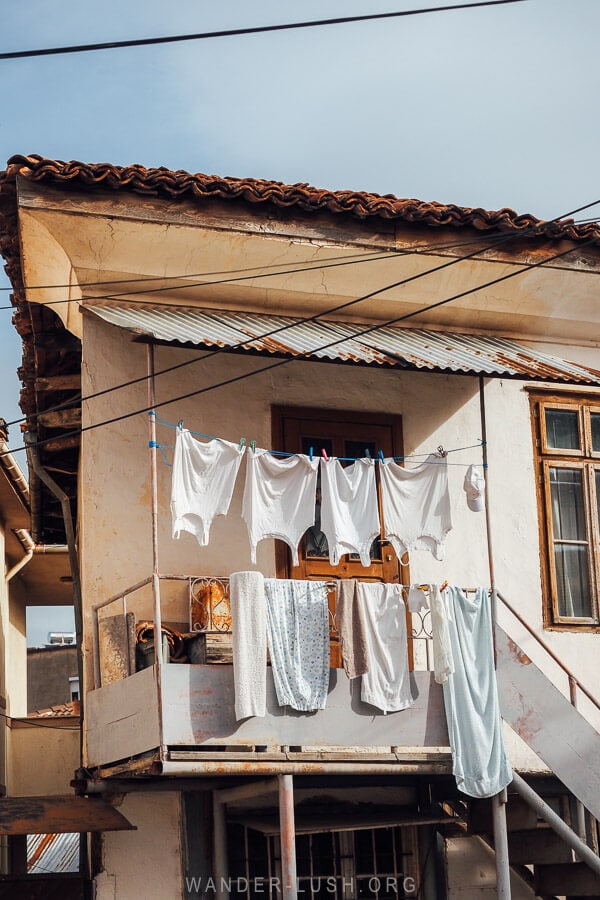
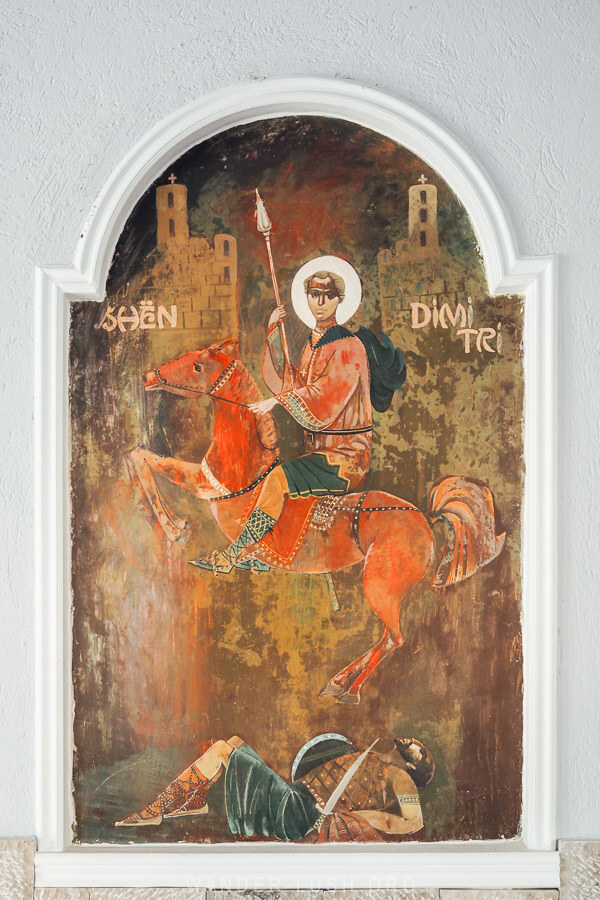
The Dormition Church of Saint Mary in Toplec (above right) has some lovely frescoes inside. Nearby, Garden Villa is a charming little cafe with excellent coffee.
Where to go next: Onward travel from Lin
From Lin, we drove 2 hours to return to Tirana. Along the way, we made short photo stops in Prrenjas (for the abandoned industrial buildings decorated with ladybug street art), and in Elbasan to see a few street art pieces and a mosque.
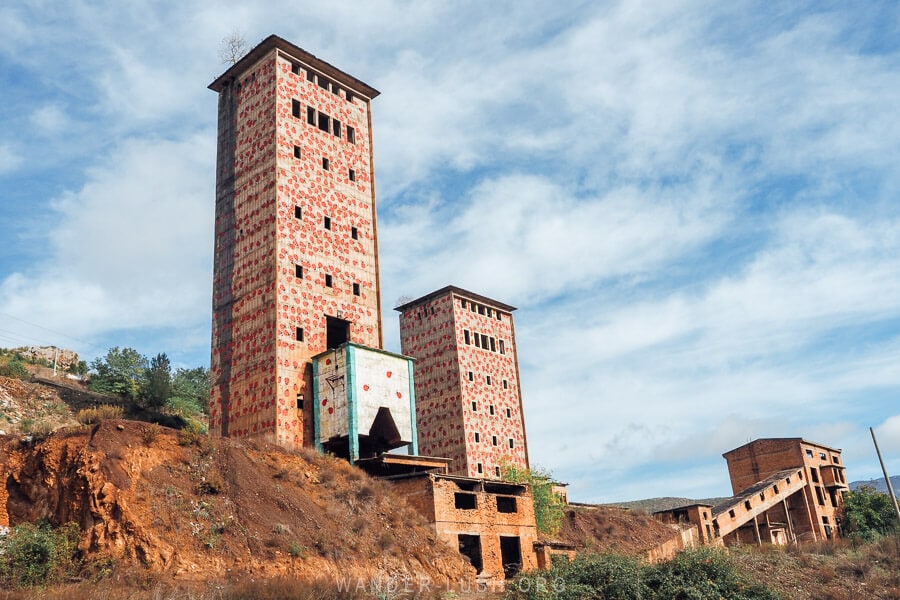
The road between Tirana and Lin follows the communist-era railroad that once connected the towns and cities in this part of Albania. Inspired by this guide, we stopped at the impressive Bushtrica Bridge, and did a bit of urbexing at the abandoned train station in Xhyrë.
In Xhyre, an elderly man approached us and tried to help us break into the old station master’s office. But alas we couldn’t get the door to budge, so had to settle for a photo of the old railway timetable from the broken window.
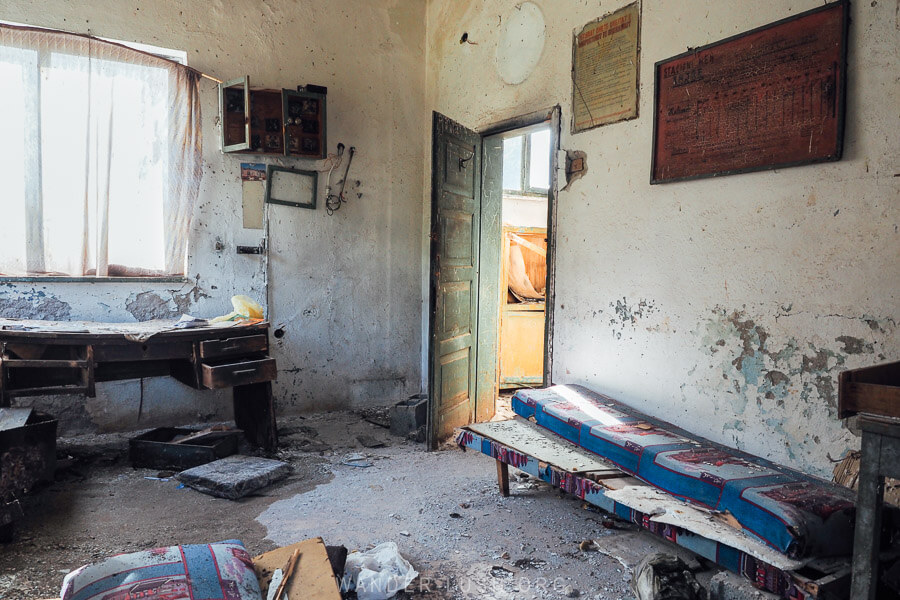
If you are reliant on public transport, you might be able to find direct buses to Tirana and Korca from Lin. Check locally with your guesthouse. Otherwise I would recommend taking a taxi or local bus to Pogradec, which has a larger bus station and better connections.
More ideas for Albania
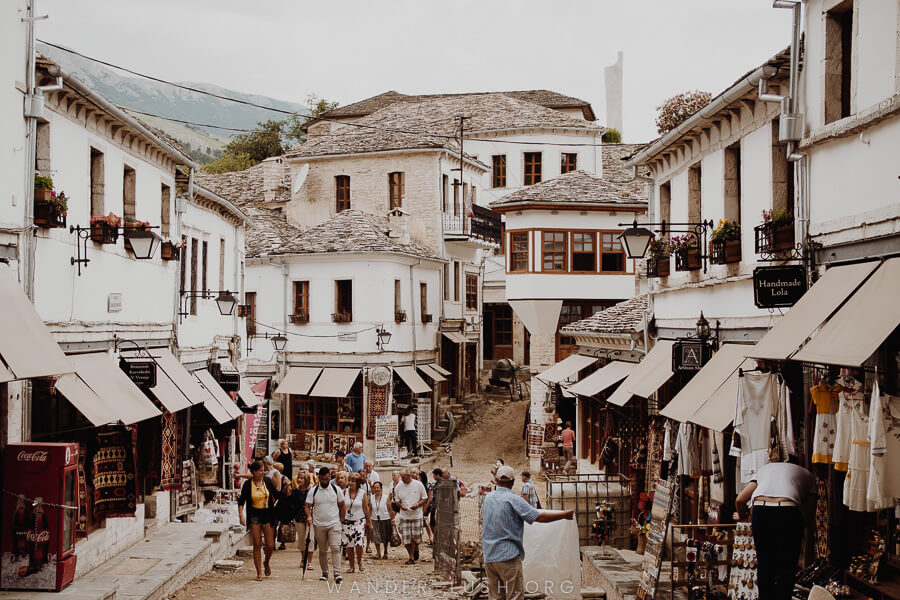
Albania Travel Guide
Discover insider tips, itinerary inspiration, and all the best things to see, do and experience in Albania!
Albania Essentials
My favourite resources and tools for planning a trip to Albania.
More from Albania
Albania Travel Guide
Discover insider tips, itinerary inspiration, and all the best things to see, do and experience in Albania!



